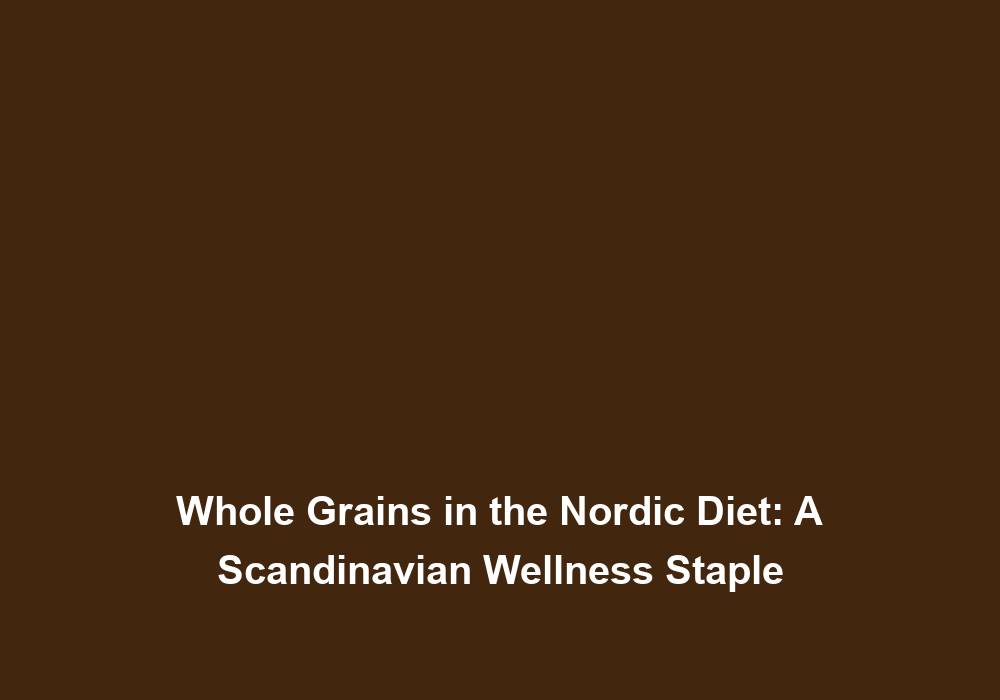Whole Grains in the Nordic Diet: A Scandinavian Wellness Staple
The Nordic Diet, also known as the Scandinavian Diet, has gained global recognition for its emphasis on whole, nutritious foods. Central to this dietary pattern are whole grains, which play a crucial role in promoting overall wellness. In this article, we will delve into the significance of whole grains in the Nordic Diet and explore their numerous health benefits.
The Nordic Diet: A Brief Overview
The Nordic Diet is a traditional dietary pattern followed by people in the Nordic countries, such as Denmark, Sweden, Norway, Finland, and Iceland. It is characterized by the consumption of locally sourced, seasonal, and sustainable foods. This wholesome diet primarily focuses on plant-based foods, including fruits, vegetables, legumes, nuts, seeds, and whole grains.
The Nordic Diet stands out due to its emphasis on whole grains. Whole grains are the unrefined versions of grains, which means they contain all three parts of the grain kernel – the bran, germ, and endosperm. This minimal processing ensures that whole grains retain their natural goodness, offering unparalleled health benefits.
Whole Grains: The Cornerstone of the Nordic Diet
Whole grains form the foundation of the Nordic Diet, delivering a rich array of essential nutrients, dietary fiber, and plant compounds. These grains are minimally processed, containing all three parts of the grain kernel – the bran, germ, and endosperm. As a result, they retain their natural goodness, offering unparalleled health benefits.
Health Benefits of Whole Grains
Including whole grains in your diet can have a profound positive impact on your well-being. Here are some notable health benefits associated with consuming whole grains:
-
Improved Digestive Health: Whole grains are an excellent source of dietary fiber, which aids in maintaining a healthy digestive system. The fiber content in whole grains promotes regular bowel movements, prevents constipation, and supports the growth of beneficial gut bacteria. This can contribute to a healthier gut and overall digestive well-being.
-
Heart Health: Research suggests that a diet rich in whole grains is associated with a reduced risk of developing cardiovascular diseases. Whole grains contain fiber, antioxidants, and phytochemicals that contribute to lower blood pressure levels, reduced inflammation, and improved cholesterol profiles. By incorporating whole grains into your Nordic Diet, you can support a healthy heart and reduce the risk of heart disease.
-
Weight Management: Whole grains are nutritionally dense and can help you feel fuller for longer periods, promoting satiety. The fiber content in whole grains slows down the digestion process, which can curb hunger and prevent overeating or snacking on unhealthy foods. Including whole grains in your meals can aid in weight management and support a healthy body weight.
-
Diabetes Prevention: Whole grains have a lower glycemic index compared to refined grains, which means they cause a slower and steadier increase in blood sugar levels. This property can help reduce the risk of type 2 diabetes and manage blood sugar levels in individuals with diabetes. By incorporating whole grains into your Nordic Diet, you can support better blood sugar control and reduce the risk of developing diabetes.
Common Whole Grains in the Nordic Diet
The Nordic Diet encompasses a variety of whole grains that are enjoyed in various forms. Some popular whole grains commonly consumed in Scandinavian countries include:
-
Barley: Barley is a versatile grain used in soups, stews, salads, and porridge. It is an excellent source of fiber, vitamins, and minerals, including selenium and manganese. Barley adds a nutty flavor and chewy texture to dishes, making it a delicious and nutritious addition to the Nordic Diet.
-
Rye: Rye is a hardy grain commonly used in bread, crispbread, and porridge. It has a distinctive flavor and is rich in dietary fiber, iron, and B-vitamins. Rye is a staple in Scandinavian cuisine and provides a hearty and satisfying element to meals.
-
Oats: Oats are a staple in the Nordic Diet and are consumed in the form of porridge, muesli, and baked goods. They are known for their high fiber content and are a good source of essential minerals like magnesium and zinc. Oats offer a creamy and comforting texture to dishes, making them a popular choice for breakfast and snacks.
-
Wheat: While wheat is not as commonly consumed in its whole form in the Nordic Diet, it is still used in various bread and pastry recipes. Whole wheat provides essential nutrients like fiber, folate, and selenium. By incorporating whole wheat products into your meals, you can increase the nutritional value of your diet.
-
Buckwheat: Although not a true grain, buckwheat is a pseudo-cereal that is gluten-free and highly nutritious. It is often used in pancakes, porridge, and as a substitute for rice or pasta. Buckwheat is rich in protein, fiber, and essential minerals like manganese and magnesium. It adds a unique flavor and texture to dishes, making it a versatile whole grain option.
Tips for Incorporating Whole Grains into Your Diet
Here are some practical tips to help you incorporate more whole grains into your daily meals:
-
Start with Breakfast: Swap refined cereal or white bread for whole grain options like oatmeal or whole grain bread for a wholesome start to your day. You can top your oatmeal with fruits, nuts, and seeds for added flavor and nutrition.
-
Experiment with Different Grains: Explore the diverse world of whole grains and try incorporating different varieties into your meals. Experiment with barley, rye, spelt, or quinoa to add variety and nutritional value. You can use these grains in salads, soups, side dishes, or as a base for hearty grain bowls.
-
Replace Refined Grains: Gradually replace refined grains, such as white rice and pasta, with their whole grain counterparts. This simple swap can boost the nutritional content of your meals. For example, you can use whole grain pasta or brown rice instead of refined options in your favorite recipes.
-
Snack Smart: Opt for whole grain snacks like air-popped popcorn, whole grain crackers, or homemade granola bars to satisfy your cravings while nourishing your body. These snacks provide a combination of fiber, protein, and essential nutrients, making them a healthier choice compared to processed snacks.
-
Read Labels: When purchasing packaged products, read the ingredient list to ensure they contain whole grains as a primary ingredient. Look for terms like whole wheat, whole oats, or whole rye. This can help you make informed choices and select products that align with the Nordic Diet principles.
Conclusion
Whole grains serve as a fundamental component of the Nordic Diet, providing a wealth of health benefits. From supporting digestive health to reducing the risk of chronic diseases, whole grains are a vital part of a balanced and nutritious diet. By incorporating a variety of whole grains into your meals, you can enhance your overall well-being and experience the Scandinavian wellness staple that is the Nordic Diet.
Disclaimer: This article is for informational purposes only and should not replace professional medical advice.







